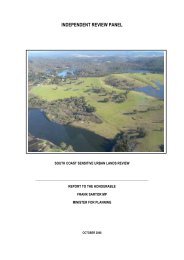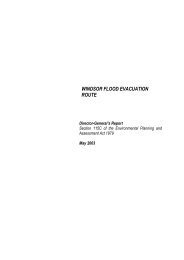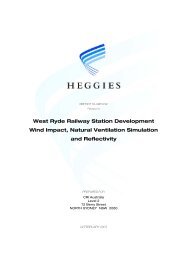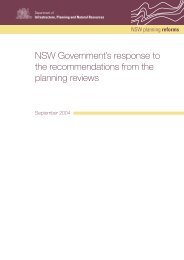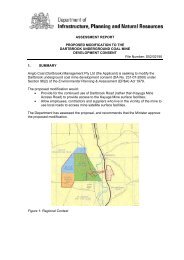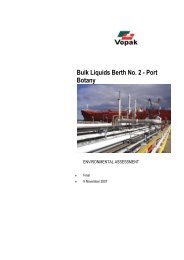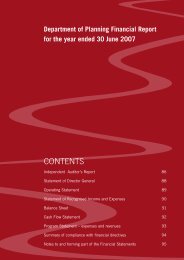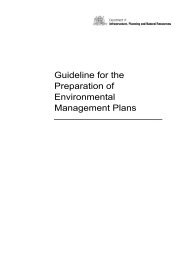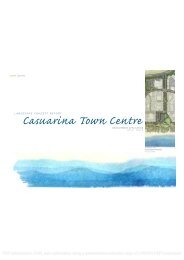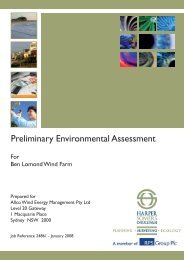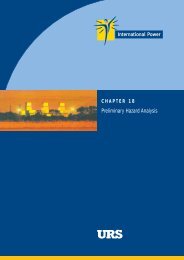Geotechnical Policy Kosciuszko Alpine Resorts - Department of ...
Geotechnical Policy Kosciuszko Alpine Resorts - Department of ...
Geotechnical Policy Kosciuszko Alpine Resorts - Department of ...
You also want an ePaper? Increase the reach of your titles
YUMPU automatically turns print PDFs into web optimized ePapers that Google loves.
<strong>Geotechnical</strong> <strong>Policy</strong><br />
<strong>Kosciuszko</strong> <strong>Alpine</strong> <strong>Resorts</strong><br />
www.dipnr.nsw.gov.au
© Crown Copyright 2003<br />
November 2003<br />
NSW <strong>Department</strong> <strong>of</strong> Infrastructure, Planning and Natural Resources<br />
www.dipnr.nsw.gov.au<br />
ISBN 0-7347-0437-2<br />
Disclaimer<br />
While every reasonable effort has been made to ensure that this<br />
document is correct at the time <strong>of</strong> publication, the State <strong>of</strong> New<br />
South Wales, its agents and employees, disclaim any and all<br />
liability to any person in respect <strong>of</strong> anything or the consequences<br />
<strong>of</strong> anything done or omitted to be done in reliance upon the whole<br />
or any part <strong>of</strong> this document.
TABLE OF CONTENTS<br />
1.0 Objectives ................................................................................................................................................. 2<br />
2.0 Definitions ................................................................................................................................................. 2<br />
3.0 When is a geotechnical report required to be lodged with a development application ............................. 5<br />
4.0 Preparing a geotechnical report ................................................................................................................ 5<br />
5.0 Circumstances in which the <strong>Department</strong> would not support a development application .......................... 7<br />
6.0 Preparation <strong>of</strong> a site classification report .................................................................................................. 7<br />
7.0 Copies required ........................................................................................................................................ 8<br />
8.0 Standard conditions .................................................................................................................................. 9<br />
9.0 Consultants and peer review ................................................................................................................... 9<br />
10.0 About the forms ........................................................................................................................................ 9<br />
11.0 Maps and accompany notes .................................................................................................................. 13<br />
Appendix A - Qualitative terminology and risk matrix ........................................................................................... 14<br />
NSW <strong>Department</strong> <strong>of</strong> Infrastructure, Planning and Natural Resources Page 1 <strong>of</strong> 14
GEOTECHNICAL POLICY<br />
KOSCIUSZKO ALPINE RESORTS<br />
1.0 Objectives<br />
1.1 The objectives <strong>of</strong> this policy are to ensure that:<br />
(a)<br />
(b)<br />
(b)<br />
(c)<br />
(d)<br />
(e)<br />
geotechnical and related structural matters are adequately investigated and documented by<br />
applicants prior to the lodgment <strong>of</strong> any development application to carry out any development<br />
subject to this policy,<br />
to establish whether or not the proposed development is appropriate to be carried out, either<br />
conditionally or unconditionally, having regard to the results <strong>of</strong> those geotechnical and related<br />
structural investigations,<br />
in the event that a proposed development, is only appropriate, if carried out subject to geotechnical<br />
and related structural engineering conditions, those conditions are able to be met and are identified<br />
by applicants prior to lodgment <strong>of</strong> the development application including all appropriate constraints<br />
and remedial actions required prior to, during and after the carrying out <strong>of</strong> the development,<br />
to ensure effective controls exist to guarantee that a development is carried out in accordance with<br />
the requirements <strong>of</strong> this policy,<br />
to ensure that the preparation <strong>of</strong> geotechnical and related structural engineering information and<br />
certificates required to be lodged by this policy are carried out by suitably qualified pr<strong>of</strong>essionals<br />
with appropriate expertise in geotechnical engineering, and<br />
that developments are only carried out if geotechnical and related structural engineering risks are<br />
identified and can be effectively addressed.<br />
1.2 Application <strong>of</strong> this policy<br />
(a)<br />
(b)<br />
(c)<br />
This policy addresses both structural and geotechnical requirements relating to geotechnical issues<br />
only. Separate structural requirements will also apply for the erection <strong>of</strong> any structure in accordance<br />
with the Building Code <strong>of</strong> Australia (BCA) and best engineering practice.<br />
This policy applies to the land to which State Environmental Planning <strong>Policy</strong> No. 73 - <strong>Kosciuszko</strong><br />
Ski <strong>Resorts</strong> (SEPP No. 73) applies.<br />
The <strong>Department</strong> will act on behalf <strong>of</strong> the Minister for Infrastructure and Planning, as the consent<br />
authority, for development control within <strong>Kosciuszko</strong> <strong>Alpine</strong> <strong>Resorts</strong> and shall administer the<br />
requirements <strong>of</strong> this policy.<br />
2.0 Definitions<br />
Any terms which are defined in the Environmental Planning & Assessment Act 1979 (E.P & A Act) or the<br />
Environmental Planning & Assessment Regulations 2000 (E.P & A Regs) here under have the same meaning when<br />
used in this policy.<br />
In this policy, the following terms have the meanings set out below:<br />
NSW <strong>Department</strong> <strong>of</strong> Infrastructure, Planning and Natural Resources Page 2 <strong>of</strong> 14
Acceptable risk – the guidance for the establishment <strong>of</strong> acceptable risk criteria, in this policy, has been based on the<br />
contents <strong>of</strong> Section 4.2.1-Property and Section 4.2.2-Loss <strong>of</strong> Life in Australian Geomechnics Society 2000 (AGS<br />
2000). Acceptable risk for loss <strong>of</strong> life is taken as, one order <strong>of</strong> magnitude, lower than the “tolerable risk” for the<br />
person most at risk, as given in table 4.2.2 <strong>of</strong> AGS 2000.The risk level for the loss <strong>of</strong> life can be can be determined by<br />
the quantitative methods outline in AGS 2000 or the semi-quantitative methods outlined in Appendix A <strong>of</strong> this policy.<br />
The risk level for loss <strong>of</strong> property can be determined by qualitative example given in AGS 2000 or by the semiquantitative<br />
method outlined in Appendix A <strong>of</strong> this policy. Acceptable risk for loss <strong>of</strong> property is taken as low or very<br />
low in the risk matrix in Appendix A.<br />
AGS 2000 – Australian Geomechanics Society, “Landslide Risk Management Concepts and Guidelines”, Australian<br />
Geomechanics Society sub committee on Landslide Risk Management, Australian Geomechanics Journal Vol. 35<br />
No.1, March 2000 also reprinted in Australian Geomechanics Journal Vol. 37 No.2, May 2002.<br />
Application means any development application which relates to land to which SEPP No. 73 applies.<br />
CPeng – Chartered Pr<strong>of</strong>essional Engineer<br />
CPgeo – Chartered Pr<strong>of</strong>essional Geologist<br />
RPgeo – Registered Pr<strong>of</strong>essional Geologist<br />
Civil engineer or structural engineer means a civil or structural engineer who is a member <strong>of</strong> a pr<strong>of</strong>essional<br />
engineering institute, is degree qualified and either has or is employed by a corporation which has pr<strong>of</strong>essional<br />
indemnity insurance <strong>of</strong> not less than $2 million, such insurance being demonstrated to the <strong>Department</strong> to be in force,<br />
for the year in which any information is submitted to the <strong>Department</strong> in accordance with this policy.<br />
DIPNR means the <strong>Department</strong> <strong>of</strong> Infrastructure, Planning and Natural Resources<br />
Final geotechnical certificate means a certificate prepared by a geotechnical engineer or engineering geologist in<br />
accordance with form 3.<br />
<strong>Geotechnical</strong> engineer or engineering geologist means a specialist geotechnical engineer or engineering geologist<br />
who is degree qualified, is a member <strong>of</strong> a pr<strong>of</strong>essional institute and who has achieved chartered pr<strong>of</strong>essional status<br />
being either CPEng or CPGeo or RPGeo with “Landslide Risk Management” as a core competence”, and either has<br />
or is employed by a corporation which has pr<strong>of</strong>essional indemnity insurance <strong>of</strong> not less than $2 million, such<br />
insurance being demonstrated to be in force for the year in which any information is submitted to the <strong>Department</strong> in<br />
accordance with this policy.<br />
<strong>Geotechnical</strong> hazard means a condition with the potential for causing the movement <strong>of</strong> rock, debris or earth, which<br />
may cause injury or death to persons or damage to, or destruction <strong>of</strong> property.<br />
<strong>Geotechnical</strong> maps means the maps marked “<strong>Geotechnical</strong> <strong>Policy</strong> A4 Map” for each <strong>of</strong> Perisher Valley (G.1, G1.1-<br />
G1.8), Smiggin Holes (G2), Guthega Village (G3), Charlotte Pass (G4), Thredbo (G5), Bullock’s Flat (G6), Kosciusko<br />
Mountain Retreat (G7), Ski Rider Motel (G8) and Sponars Chalet (G9).<br />
<strong>Geotechnical</strong> report means a report prepared by and/or technically verified by a geotechnical engineer or<br />
engineering geologist as defined by this policy, which incorporates each <strong>of</strong> the elements, where applicable to the type<br />
<strong>of</strong> development, described in item “4.0 – Preparation <strong>of</strong> the geotechnical report” <strong>of</strong> this policy.<br />
Minister means Minister for Infrastructure and Planning.<br />
NSW <strong>Department</strong> <strong>of</strong> Infrastructure, Planning and Natural Resources Page 3 <strong>of</strong> 14
<strong>Policy</strong> means <strong>Geotechnical</strong> <strong>Policy</strong> – <strong>Kosciuszko</strong> <strong>Alpine</strong> <strong>Resorts</strong><br />
PCA means principal certifying authority<br />
Related land means land including roads and thoroughfares that could affect or could be affected by any<br />
development proposed on a site.<br />
Requirements include all acts, statutes, regulations, by-laws, ordinances, codes, delegated legislation, all approvals<br />
granted under any such instrument, the BCA and any applicable Australian Standard<br />
Risk means a measure <strong>of</strong> the probability and severity <strong>of</strong> an adverse effect to health, property or the environment.<br />
Site means the whole <strong>of</strong> any allotment (lease or sub-lease) <strong>of</strong> land to which the carrying out <strong>of</strong> any development<br />
relates.<br />
Site classification means a classification <strong>of</strong> the site in accordance with AS 2870.1 Australian Standard - Residential<br />
Slabs and Footings, 1996 amendments 1 to 4.<br />
Structural design means the selection and proportioning <strong>of</strong> load carrying elements incorporated in a structure, which<br />
require certification by a structural or civil engineer.<br />
Structural document means a document (which may be in the form <strong>of</strong> drawings) from a structural engineer or civil<br />
engineer that makes recommendations in respect <strong>of</strong> the structural design and structural works required for any<br />
structure to be erected on the site which, under this policy, requires certification in accordance with form 2.<br />
Structural works means the elements <strong>of</strong> any structure designed by a structural or civil engineer.<br />
The <strong>Department</strong> means the <strong>Department</strong> <strong>of</strong> Infrastructure, Planning and Natural Resources<br />
Verifier means a geotechnical engineer or engineering geologist, as defined by this policy, who verifies a<br />
geotechnical report.<br />
3.0 When is a geotechnical report required to be lodged with a development application<br />
3.1 All development applications, which include but are not limited to, the erection <strong>of</strong> any buildings or the carrying<br />
out <strong>of</strong> any works, or the demolition <strong>of</strong> any buildings on sites identified to be located within the areas<br />
designated “G” on the accompanying geotechnical maps for the <strong>Kosciuszko</strong> <strong>Alpine</strong> Resort areas, are to be<br />
accompanied by a geotechnical report, other than a development application for a development as specified<br />
below:<br />
(a)<br />
building alterations (including the making <strong>of</strong>, or an alteration to the size <strong>of</strong>, any opening in a wall or<br />
ro<strong>of</strong> <strong>of</strong> a building, such as a doorway, window or skylight) comprising:<br />
(i)<br />
(ii)<br />
non-structural alterations to the exterior <strong>of</strong> a building, such as painting, plastering,<br />
cement rendering, cladding, attaching fillings and decorative work; or<br />
non-structural alterations to the interior <strong>of</strong> a building that do not result in the current loadbearing<br />
capacity <strong>of</strong> the building being exceeded;<br />
(b)<br />
(c)<br />
demolition (carried out in accordance with AS 2601-1991: The Demolition <strong>of</strong> Structures) <strong>of</strong> any<br />
structure that covers an area <strong>of</strong> not more than twenty five square metres;<br />
the erection <strong>of</strong> any building within an existing allotment comprising:<br />
NSW <strong>Department</strong> <strong>of</strong> Infrastructure, Planning and Natural Resources Page 4 <strong>of</strong> 14
(i)<br />
(ii)<br />
(iii)<br />
an advertising structure or structures; or<br />
a verandah or porch fully supported by an existing building; or<br />
non-structural repairs to or maintenance <strong>of</strong> an existing building,<br />
provided that no work to an existing building results in the current load bearing capacity <strong>of</strong> the<br />
building being exceeded; or<br />
(d)<br />
(e)<br />
minor earthworks, including landscaping, not involving excavations or fill in excess <strong>of</strong> one metre in<br />
vertical height; or<br />
minor construction works which present minimal or no geotechnical impact on the site or related land<br />
as determined and certified (form 4) by a geotechnical engineer or engineering geologist as defined<br />
by this policy.<br />
3.2 Any development application not accompanied by a geotechnical report, which is required to be lodged<br />
under clause 4.1 <strong>of</strong> this policy, may not be accepted by the department until such time as it is accompanied<br />
by a satisfactory geotechnical report.<br />
4.0 Preparation <strong>of</strong> a geotechnical report<br />
4.1 The geotechnical report to be submitted with a development application required under this policy is to<br />
include the following elements:<br />
(a)<br />
(b)<br />
(c)<br />
(d)<br />
(e)<br />
An assessment <strong>of</strong> the risk posed by all reasonably identifiable geotechnical hazards which have the<br />
potential to either individually or cumulatively impact upon people or property upon the site or related<br />
land to the proposed development in accordance with the guidelines set out in ‘Landslide Risk<br />
Management Concepts and Guidelines’ first published in the Australian Geomechanics Journal, Vol.<br />
35 No.1, March 2000 (guidelines). Note: Appendix A provides an example <strong>of</strong> qualitative terminology<br />
for use in assessing risk to life and property.<br />
Plans and sections <strong>of</strong> the site and related land from survey and field measurements with contours<br />
and key features identified, including the locations <strong>of</strong> the proposed development,<br />
buildings/structures on both the subject site and adjoining site, stormwater drainage, sub-surface<br />
drainage, water supply and sewerage pipelines, trees and other identifiable geotechnical hazards.<br />
Details <strong>of</strong> all site inspections and site investigations and any other information used in preparation <strong>of</strong><br />
the geotechnical report. A site inspection is required in all cases. Site investigation may require subsurface<br />
investigation; appropriate investigation may involve boreholes and/or test pit excavations or<br />
other methods necessary to adequately assess the geotechnical/geological model for the site. At<br />
Thredbo, reference may be made to the suite <strong>of</strong> existing geotechnical data and regional studies held<br />
by <strong>Kosciuszko</strong> Thredbo Pty Ltd, as part <strong>of</strong> the information to be used in assessing the site. Where<br />
similar information data exists for the other <strong>Kosciuszko</strong> Ski <strong>Resorts</strong> then this information may be<br />
similarly used in assessing the site.<br />
Photographs and/or drawings <strong>of</strong> the site and related land adequately illustrating all geotechnical<br />
features referred to in the geotechnical report, as well as the locations <strong>of</strong> the proposed development.<br />
Presentation <strong>of</strong> a geological model <strong>of</strong> the site and related land showing the proposed development,<br />
including an analysis <strong>of</strong> sub-surface conditions, taking into account thickness <strong>of</strong> the topsoil,<br />
colluvium and residual soil layers, depth to underlying bedrock, and the location and depth <strong>of</strong><br />
ground-water.<br />
NSW <strong>Department</strong> <strong>of</strong> Infrastructure, Planning and Natural Resources Page 5 <strong>of</strong> 14
(f)<br />
A conclusion as to whether the site is suitable for the development proposed to be carried out either<br />
conditionally or unconditionally. This must be in the form <strong>of</strong> a specific statement that the site is<br />
suitable for the development proposed to be carried out, subject to the following conditions:<br />
(i)<br />
Conditions to be provided to establish the design parameters, including but not limited to;<br />
• footing levels and supporting rock quality,<br />
• degree <strong>of</strong> earth and rock cut and fill,<br />
• recommendations for excavation batters,<br />
• parameters, bearing capacities, and recommendations for use in the design <strong>of</strong> all<br />
structural works including all footings, retaining walls, surface and sub-surface<br />
drainage,<br />
• recommendations for the selection <strong>of</strong> building structure systems consistent with the<br />
geotechnical assessment <strong>of</strong> risk, and<br />
• signing <strong>of</strong> form 2 as the mechanism to check that these parameters have been<br />
interpreted correctly and incorporated into the structural design<br />
(ii)<br />
Conditions applying to the detailed design to be undertaken for the construction certificate,<br />
including but not limited to;<br />
• any structural design relating to geotechnical aspects <strong>of</strong> the proposal is to be checked<br />
and certified by a suitably qualified and experienced geotechnical engineer,<br />
• any other design conditions the geotechnical engineer preparing the geotechnical<br />
report believes are required in the design phase in order to ensure the design will<br />
achieve the “acceptable risk management” level as defined in this policy for potential<br />
loss <strong>of</strong> both property and life, and<br />
• signing <strong>of</strong> form 2 as the mechanism to check that these design conditions have been<br />
interpreted correctly and incorporated into the structural design.<br />
(iii)<br />
Conditions applying to the construction phase, including but not limited to;<br />
• constructed works which require inspection and/or sign<strong>of</strong>f by a suitably qualified and<br />
experienced geotechnical engineer. The report must highlight and detail the inspection<br />
regime to provide the builder with adequate notification for all necessary inspections,<br />
• any other construction conditions including works methodology and temporary works<br />
that the geotechnical engineer preparing the geotechnical report believes are required<br />
in the construction phase to ensure the design will achieve the “acceptable risk<br />
management” level as defined in this policy for potential loss <strong>of</strong> both property and life,<br />
and<br />
NSW <strong>Department</strong> <strong>of</strong> Infrastructure, Planning and Natural Resources Page 6 <strong>of</strong> 14
• signing form 3 as the mechanism to verify that the above methodology and inspections<br />
have been completed in accordance with the report.<br />
(iv)<br />
Conditions regarding ongoing management <strong>of</strong> the site/structure, including but not limited to;<br />
• any conditions that may be required for the ongoing mitigation and maintenance <strong>of</strong> the<br />
site and the proposal, from a geotechnical viewpoint.<br />
(g)<br />
A copy <strong>of</strong> form 1 bearing the original signature <strong>of</strong> the engineering geologist or geotechnical engineer<br />
as defined by this policy, who has either prepared or technically verified the geotechnical report.<br />
5.0 Circumstances in which the <strong>Department</strong> would not support a development application<br />
5.1 Where, under clause 4.1, a development application is required to be accompanied by a geotechnical report,<br />
then this report must be prepared and/or verified by a geotechnical engineer or engineering geologist as<br />
defined by this policy, through the submission <strong>of</strong> form 1. Where a geotechnical report accompanying a<br />
development application, has been prepared by a geotechnical engineer or engineering geologist with<br />
qualifications which do not meet the requirements <strong>of</strong> this policy then the <strong>Department</strong> shall refuse to support<br />
the development application, until the geotechnical report has been verified by a geotechnical engineer or<br />
engineering geologist as defined by this policy.<br />
5.2 The <strong>Department</strong> will not support a development application, on geotechnical grounds, if a geotechnical report<br />
or independent review <strong>of</strong> a geotechnical report accompanying an application, identifies the risk to property<br />
and/or life posed by the geotechnical hazard as greater than the level <strong>of</strong> “acceptable risk” (as defined by this<br />
policy and AGS 2000) after all feasible measures to reduce the risk have been considered and/or where the<br />
geotechnical report does not follow the methodology <strong>of</strong> AGS 2000.<br />
6.0 Preparation <strong>of</strong> a site classification report<br />
All development applications which involve the erection <strong>of</strong> any structure (other than a structure identified in<br />
clause 3.1 (a)-(e) <strong>of</strong> this policy) on sites identified to be outside the area designated “G” on the<br />
accompanying geotechnical maps do not require an accompanying geotechnical report. However, instead<br />
they must be accompanied by a site classification report prepared in accordance with AS 2870-1996 -<br />
Residential Slabs and Footings. This report must be prepared by a geotechnical engineer or engineering<br />
geologist as defined by this policy and must contain a site classification report and the following;<br />
(a)<br />
A conclusion as to whether the site is suitable for the development proposed to be carried out either<br />
conditionally or unconditionally. This must be in the form <strong>of</strong> a specific statement that the site is<br />
suitable for the development proposed to be carried out, subject to the following conditions if<br />
required:<br />
(h) Conditions to be provided to establish the design parameters, including but not limited to:<br />
• footing levels and supporting rock quality,<br />
• degree <strong>of</strong> earth and rock cut and fill,<br />
• recommendations for excavation batters,<br />
• parameters, bearing capacities, and recommendations for use in the design <strong>of</strong> all<br />
NSW <strong>Department</strong> <strong>of</strong> Infrastructure, Planning and Natural Resources Page 7 <strong>of</strong> 14
structural works including all footings, retaining walls, surface and sub-surface<br />
drainage, and<br />
• signing <strong>of</strong> form 2A as the mechanism to check that these design conditions have been<br />
interpreted correctly and incorporated into the structural design.<br />
(ii)<br />
Conditions applying to the detailed design to be undertaken for the construction certificate,<br />
including but not limited to:<br />
• any structural design relating to geotechnical aspects <strong>of</strong> the proposal is to be checked<br />
and certified by a suitably qualified and experienced geotechnical engineer,<br />
• any other design conditions the geotechnical engineer preparing the site classification<br />
report believes are required in the design phase, and<br />
• signing <strong>of</strong> form 2A as the mechanism to check that these design conditions have been<br />
interpreted correctly and incorporated into the structural design.<br />
(iii)<br />
Conditions applying to the construction phase, including but not limited to:<br />
• constructed works which require inspection and/or sign<strong>of</strong>f by a suitably qualified and<br />
experienced geotechnical engineer. The report must highlight and detail the inspection<br />
regime to provide the builder with adequate notification for all necessary inspections,<br />
• any other construction conditions including works methodology and temporary works<br />
that the geotechnical engineer preparing the geotechnical report believes are required<br />
in the construction phase, and<br />
• signing <strong>of</strong> form 3A as the mechanism to verify that the above methodology and<br />
inspections have been completed in accordance with the report.<br />
(iv)<br />
Conditions regarding ongoing management <strong>of</strong> the site/structure, including but not limited to:<br />
• any conditions that may be required for the ongoing mitigation and maintenance <strong>of</strong> the<br />
site and the proposal, from a geotechnical viewpoint.<br />
(b)<br />
A copy <strong>of</strong> form 1A bearing the original signature <strong>of</strong> the engineering geologist or geotechnical<br />
engineer as defined by this policy, who has prepared or technically verified the site<br />
classification report.<br />
Note: Where the site classification report contains no design recommendations, parameters or<br />
requirement for geotechnical site inspection, then neither form 2A or form 3A are required.<br />
7.0 Copies required<br />
7.1 If, by operation <strong>of</strong> clause 3.1 or 6.0, a geotechnical report or site classification report is required to be lodged<br />
with a development application, then at least three signed complete copies <strong>of</strong> the geotechnical report must<br />
NSW <strong>Department</strong> <strong>of</strong> Infrastructure, Planning and Natural Resources Page 8 <strong>of</strong> 14
e lodged.<br />
8.0 Standard conditions<br />
8.1 Prior to the occupation <strong>of</strong> any structure or the commencement <strong>of</strong> any use authorised by a development<br />
consent, the applicant must submit to the PCA, a copy <strong>of</strong> the final geotechnical certificate (form 3), bearing<br />
the original signature <strong>of</strong> the author or verifier <strong>of</strong> the geotechnical report. The PCA is to refuse to issue an<br />
occupation certificate, regardless <strong>of</strong> whether the occupancy certificate application is <strong>of</strong> interim or final status,<br />
until it receives the final geotechnical certificate (form 3). Where the original author or verifier <strong>of</strong> the<br />
geotechnical report is unavailable to sign form 3, the <strong>Department</strong> will accept another suitably qualified<br />
geotechnical engineer as the authority to sign <strong>of</strong>f.<br />
8.2 The <strong>Department</strong> may, if appropriate, impose conditions on a development consent requiring the lodgement <strong>of</strong><br />
interim geotechnical certificates related to the stages <strong>of</strong> the construction <strong>of</strong> any development the subject <strong>of</strong><br />
the consent. The form <strong>of</strong> any such interim certificate must be consistent with forms 3, amended as required,<br />
to reflect its status as an interim certificate only.<br />
8.3 Any development consent for a development subject to this policy may incorporate condition <strong>of</strong> consent<br />
requiring the applicant to:<br />
(a)<br />
(b)<br />
(c)<br />
maintain any ongoing maintenance procedures and/or carry out any monitoring identified in the final<br />
geotechnical certificate,<br />
provide an annual certificate to the <strong>Department</strong> from a geotechnical engineer or engineering<br />
geologist confirming compliance with requirement (a) above, and<br />
comply with the design requirements <strong>of</strong> the site classification.<br />
9.0 Consultants and peer review<br />
9.1 Where a geotechnical report contains a recommendation for a separate analysis <strong>of</strong> the site to be carried out<br />
by another consultant, for example a flood study to be compiled by a hydrological consultant, this<br />
recommendation is to be highlighted to the applicant in the submission <strong>of</strong> the geotechnical report. This would<br />
enable the applicant to engage the required consultant and obtain the necessary report prior to the<br />
lodgement <strong>of</strong> the development application.<br />
9.2 This policy requires that the structural or civil engineer, who prepares the structural documentation, is a civil<br />
or structural engineer as defined by this policy. This policy also requires that the engineer in preparing the<br />
structural documentation, has viewed and where necessary used the recommendations given in the<br />
geotechnical report for the same development. These requirements need to be verified by accompanying the<br />
submission <strong>of</strong> the structural documentation with a completed copy <strong>of</strong> form 2<br />
9.3 The <strong>Department</strong> retains the right to have a geotechnical report submitted with a development application,<br />
peer reviewed by an independent geotechnical engineer or engineering geologist.<br />
10.0 About the forms<br />
Copies <strong>of</strong> the forms are available from the <strong>Department</strong>’s <strong>of</strong>fice in Jindabyne. The forms are available in hard copy or<br />
digital form.<br />
10.1 Form 1 - Declaration and certification made by geotechnical engineer or engineering geologist in a<br />
geotechnical report.<br />
When is Form 1 to be submitted?<br />
NSW <strong>Department</strong> <strong>of</strong> Infrastructure, Planning and Natural Resources Page 9 <strong>of</strong> 14
Form 1 is to be submitted with a geotechnical report. Attach form 1 to the inside cover <strong>of</strong> the geotechnical<br />
report.<br />
Why is form 1 necessary?<br />
This form is essential to verify that the author <strong>of</strong> a geotechnical report is a geotechnical engineer or<br />
engineering geologist as defined by this policy. Alternatively, where a geotechnical report has been prepared<br />
by a pr<strong>of</strong>essional person not recognised by this geotechnical policy, then form 1 may be used as technical<br />
verification <strong>of</strong> the geotechnical report if signed by a geotechnical engineer or engineering geologist as<br />
defined by this policy.<br />
What if form 1 is not attached?<br />
Where a geotechnical report is submitted without an appropriately signed copy <strong>of</strong> form 1, the certifying<br />
authority may refuse to accept the report unless accompanied by a completed form 1.<br />
10.2 Form 2 – Declarations and certification made by structural engineer or civil engineer and geotechnical<br />
engineer or engineering geologist in relation to a geotechnical report<br />
When is form 2 submitted?<br />
This form must be attached with the submission <strong>of</strong> the structural documentation required for the<br />
determination <strong>of</strong> a construction certificate or combined development application and construction certificate<br />
submission. The applicant must issue a copy <strong>of</strong> the structural documents and form 2 to the geotechnical<br />
engineer who prepared or technically verified the geotechnical report for the development application now<br />
requiring a construction certificate.<br />
Why is form 2 necessary?<br />
Form 2 is essential, as it provides evidence to the certifying authority determining the construction certificate,<br />
that structural documents have been prepared or verified by a structural or civil engineer as defined by this<br />
policy, and that the structural documents have been prepared in accordance with the recommendations<br />
given in the geotechnical report for the same development.<br />
Form 2 is also essential to establish that the recommendations given in the geotechnical report have been<br />
interpreted and incorporated into the structural design as originally intended by the geotechnical engineer in<br />
preparing the geotechnical report.<br />
What if form 2 is not submitted?<br />
If a completed form 2 is not attached to the structural documents submitted to the certifying authority with the<br />
application for a construction certificate, then the certifying authority must refuse to issue a construction<br />
certificate until a completed form 2 is submitted.<br />
10.3 Form 3 – Final geotechnical certificate<br />
When is form 3 submitted?<br />
This form must be submitted at the completion <strong>of</strong> a project, with an application for occupation certificate from<br />
the PCA.<br />
Why is form 3 necessary?<br />
Form 3 is essential, as it provides verification that the development works have been carried out in<br />
accordance with the requirements <strong>of</strong> the geotechnical report, and any subsequent geotechnical requirements<br />
introduced during the construction process.<br />
NSW <strong>Department</strong> <strong>of</strong> Infrastructure, Planning and Natural Resources Page 10 <strong>of</strong> 14
When do you need a geotechnical engineer to inspect the site?<br />
The purpose <strong>of</strong> this form is to ensure that the recommendations made in geotechnical report have been<br />
complied with during construction. Where required the geotechnical engineer or engineering geologist who<br />
prepared and/or verified the report will carry out site inspections as determined by the report prior to signing<br />
form 3. It is advised that the geotechnical report contains a highlighted reference to this requirement to<br />
enable the builder to give adequate notification for such inspections.<br />
What if form 3 is not submitted?<br />
If a completed form 3 is not submitted with an application for occupation certificate then the PCA must refuse<br />
to issue an occupation certificate until a completed form 3 is submitted.<br />
10.4 Form 4 – Minimal impact certification<br />
When is form 4 required to be submitted?<br />
This form may be used where minor construction works which present minimal or no geotechnical impact on<br />
the site or related land are proposed to be erected within the “G” line area <strong>of</strong> the geotechnical maps. A<br />
geotechnical engineer or engineering geologist must inspect the site and/or review the proposed<br />
development documentation to determine if the proposed development requires a geotechnical report to be<br />
prepared to accompany the development application. Where the geotechnical engineer determines that such<br />
a report is not required then they must complete form 4 and attach design recommendations where required.<br />
A copy <strong>of</strong> form 4 with design recommendation, if required, must be submitted with the development<br />
application.<br />
Why is form 4 necessary?<br />
Form 4 was developed as a way <strong>of</strong> allowing a relatively small inconsequential development, proposed within<br />
the “G” line, to proceed without the need for a geotechnical report to be produced, in accordance with the<br />
policy. The consent authority is willing to accept an application for this type <strong>of</strong> development, if form 4A is<br />
completed by an appropriately qualified geotechnical engineer certifying that the impact from the<br />
development is so minimal that a report is not required. However in all situations, a site classification report,<br />
prepared in accordance with AS 2870.1, will be required.<br />
10.5 Form 1A – Declaration and certification made by geotechnical engineer or engineering geologist in a<br />
site classification report<br />
When is form 1A required to be submitted?<br />
Where a structure is proposed to be erected outside the “G” line area <strong>of</strong> the geotechnical maps, then a<br />
geotechnical report is not required to be submitted with the development application. However, in this<br />
circumstance a site classification report is required to be prepared and submitted with the development<br />
application.<br />
Why is form 1A necessary?<br />
Form 1A is to be signed and submitted with this report to certify the credentials <strong>of</strong> the geotechnical engineer<br />
who either prepared or verified the report and that the report was prepared in accordance with AS 2870-<br />
1996. Attach form 1A to the inside cover <strong>of</strong> the site classification report.<br />
What if form 1A is not attached?<br />
NSW <strong>Department</strong> <strong>of</strong> Infrastructure, Planning and Natural Resources Page 11 <strong>of</strong> 14
Where a geotechnical report is submitted without an appropriately signed copy <strong>of</strong> form 1A attached, the<br />
<strong>Department</strong> will refuse to accept the report unless accompanied by a completed form 1A.<br />
10.6 Form 2A - Declarations and certification made by structural engineer or civil engineer and<br />
geotechnical engineer or engineering geologist in relation to a site classification report<br />
When is form 2A required to be submitted?<br />
This form must be attached to the structural documentation accompany any submission <strong>of</strong> a construction<br />
certificate to the certifying authority for determination, for a development proposed outside the “G” line. The<br />
applicant must issue a copy <strong>of</strong> the structural documents and signed form 2A to the geotechnical engineer<br />
who prepared or technically verified the site classification report for the development application now<br />
requiring a construction certificate.<br />
Why is form 2A necessary?<br />
Form 2A is essential, as it provides evidence to the certifying authority determining the construction<br />
certificate, that structural documents have been prepared or verified by a structural or civil engineer as<br />
defined by this policy and that the structural documents have been prepared in accordance with the<br />
recommendations given in the site classification report for the same development.<br />
Form 2A is also essential to establish that the recommendations given in the site classification report have<br />
been interpreted and incorporated in to the structural design as originally intended by the geotechnical<br />
engineer who prepared and/or technically verified the site classification report.<br />
What if form 2A is not submitted?<br />
If a completed form 2A is not attached to the structural documents submitted to the certifying authority with<br />
the application for a construction certificate then the certifying authority must refuse to issue a construction<br />
certificate until a completed form 2A is submitted.<br />
10.7 Form 3A - Final geotechnical certificate for a site classification report<br />
When is form 3A submitted?<br />
This form must be submitted at the completion <strong>of</strong> a project, prior to occupation <strong>of</strong> the premises and prior to<br />
the issue <strong>of</strong> an occupancy certificate from the <strong>Department</strong> , where the development was constructed outside<br />
the “G” line.<br />
Why is form 3A necessary?<br />
Form 3A is necessary, as it provides certification that the building works have been carried out in accordance<br />
with the requirements <strong>of</strong> the site classification report, and any subsequent geotechnical requirements<br />
introduced during the construction process.<br />
When do you need a geotechnical engineer to inspect the site?<br />
The purpose <strong>of</strong> this form is to ensure that the recommendations made in site classification report have been<br />
complied with during construction. In most cases the geotechnical engineer or engineering geologist who<br />
prepared and/or verified the report will need to observe the foundation materials, excavation cut and fill<br />
retention systems, subsoil drainage, etc prior to signing form 3A. It is advised that the site classification<br />
report contains a highlighted reference to this requirement to enable the builder to give adequate notification<br />
for such inspections, where required.<br />
What if form 3A is not submitted?<br />
NSW <strong>Department</strong> <strong>of</strong> Infrastructure, Planning and Natural Resources Page 12 <strong>of</strong> 14
If a completed form 3A is not submitted with an application for an occupation certificate then the PCA must<br />
refuse to issue an occupation certificate until a completed form 3A is submitted.<br />
11.0 Maps and accompany notes<br />
Copies <strong>of</strong> the geotechnical maps are available from the <strong>Department</strong>’s <strong>of</strong>fice in Jindabyne. The maps are<br />
available in hard copy or digital form. The geotechnical maps may also be downloaded from the<br />
<strong>Department</strong>’s website (www.dipnr.nsw.gov.au). The geotechnical maps numbered G1 to G6 inclusive were<br />
prepared by GHD-Longmac Pty Ltd for the National Parks and Wildlife Service as part <strong>of</strong> NPWS - A4<br />
<strong>Geotechnical</strong> <strong>Policy</strong>. The <strong>Department</strong> has incorporated these same maps into this policy with the permission<br />
<strong>of</strong> National Parks and Wildlife Service. The <strong>Department</strong> commissioned GHD-Longmac Pty Ltd to prepared<br />
additional maps <strong>of</strong> the areas around Sponars Chalet at Diggers Creek, Ski Rider Motel at Wilsons Valley and<br />
Kosciusko Mountain Retreat at Sawpit Creek.<br />
Accompany notes to the geotechnical maps are available from the Jindabyne <strong>of</strong>fice <strong>of</strong> the <strong>Department</strong>.<br />
The Jindabyne <strong>of</strong>fice <strong>of</strong> the <strong>Department</strong> is located at Snowy River Avenue in Jindabyne. The contact phone<br />
number is (02) 6456 1733.<br />
NSW <strong>Department</strong> <strong>of</strong> Infrastructure, Planning and Natural Resources Page 13 <strong>of</strong> 14
APPENDIX A<br />
QUALITATIVE TERMINOLOGY AND RISK MATRIX<br />
Landslide risk assessment – Example <strong>of</strong> qualitative terminology for use in assessing risk to property<br />
Qualitative measures <strong>of</strong> likelihood<br />
Level Descriptor Description<br />
A<br />
B<br />
C<br />
D<br />
E<br />
F<br />
Note:<br />
ALMOST CERTAIN The event is expected to occur<br />
LIKELY<br />
The event will probably occur under adverse conditions<br />
POSSIBLE<br />
The event could occur under adverse conditions<br />
UNLIKELY<br />
The event might occur under very adverse circumstances<br />
RARE<br />
The event is conceivable but only under exceptional circumstances.<br />
NOT CREDIBLE The event is inconceivable or fanciful<br />
“.“ means that the indicative value may vary by say ± • order <strong>of</strong> magnitude, or more.<br />
Indicative<br />
Annual<br />
Probability<br />
>.10¯¹<br />
.10¯²<br />
.10¯³<br />
.10¯⁴<br />
.10¯⁵<br />



